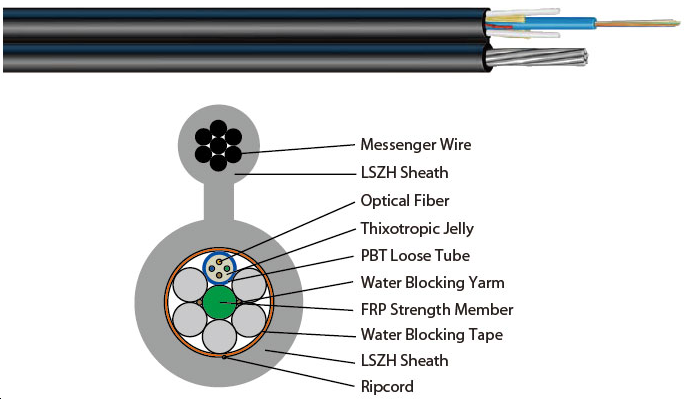- Related articles
- What is a SFP module?
- Optical Transceivers for Cisco WS-C3650-48FS-E Switch
- What is GJFJH Fiber Optic Cable?
- Optical Transceivers for Cisco SF350-48-K9-EU Switch
- All Cisco DWDM-XENPAK-47.72's information (List price, Specs, Datasheet PDF, Compatibility
- What is a single mode fiber?
- All Cisco DWDM-XENPAK-50.92's information (List price, Specs, Datasheet PDF, Compatibility
- Optical Transceivers for Cisco N3K-C3172TQ-32T= Switch
- Optical Transceivers for Cisco WS-C3650-24PWS-S Switch
- The Difference between Ethernet PCI Adapter and Network Interface Card

Definition of Overhead Fiber Optic Cables
An overhead fiber optic cables are cables used in transmission of data over a long distance. Normally, these cables are fixed on utility poles. Consequently, they are coated with PE jacket to protect the inner part from various environmental factors such as rain, sun, dust etc. Under the sheath, there is a metallic buffer tube which contains 1-12 fibers. In North America, overhead fiber optic cables are mostly used in fixing telephone and TV line. They are used to connect remote building for effective communication. Additionally, overhead fiber optic cables are used to connect several building sites over a wide geographical area. In some conditions, the overhead cables can be integrated in the power conductor for effective communication.
Structure of Overhead Fiber Optic Cables
Cables are arranged on poles with the most dangerous cables, that is, those carrying power, strung highest. Overhead cable systems also include a number of different components for managing signal cables. These include splicing systems that allow multi-conductor cables for distributing telephone signals and snowshoe-shaped devices for reversing the direction of cables.
When metal-based telephone wires are strung on the same utility poles as the power lines, they can pick up noise from the power line. Modern fiber optic telephone cable has the advantage that it can be strung next to power lines without interference.
Features/ Characteristics of Overhead Fiber Optic Cables
Fiber counts up to 144
Optical unit provides exceptional mechanical and thermal protection for fibers
Thick-walled aluminum pipe provides hermetic seal for optical units, excellent crush resistance and low resistivity
Stranded wires selected to optimize mechanical and electrical properties
Dielectric optical units are available with 6, 8, 12, 18 and 24 fibers
Supplied with up to 6 optical units, depending on fiber count
Uses of Overhead Fiber Optic Cables
The Overhead Fiber Optic Cables are mostly used in connecting the electronic devices such as the Television and Radio. Consequently, Overhead Fiber Optic Cable can also connect buildings especially if they are located with the same area for effective communication.
Conclusion
Overhead fiber optic cables play a really important role in long distance telecommunication, especially in some rural areas where is rapidly developing, demands of overhead fiber optic cables are increasing for the construction, while there is still a few people having a good knowledge about it. This article gives the basic and clear knowledge about overhead cables, which is quite useful for people who is interested or sales who want to improve business with customers in fiber optic communication.






































































